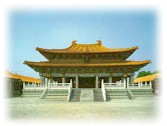| back  photo1 photo1
 photo2 photo2
 photo3 photo3
|
A small town in
Shandong provice. It was the
hometown of Confucius,
the celebrated thinker, philosopher and educator.
Population, 620,000. Qufu gained its fame
because of its extraordinary son, Confucius. At its peak during the Zhou dynasty (1200-221
BC) Qufu was the most cultural city in entire China. Today, it's a pleasant and a bit
sleepy small town. Qufu is located between the River Si and the River Yi in the southwest
part of Shangdong Province. To the north and east of Qufu are Mount Tai and Mount Yimeng,
while to the south and west are Nafu and the Great Plain of Pingye. Qufu gained its fame
because of its extraordinary son, Confucius. At its peak during the Zhou dynasty (1200-221
BC) Qufu was the most cultural city in entire China. Today, it's a pleasant and a bit
sleepy small town. Qufu is located between the River Si and the River Yi in the southwest
part of Shangdong Province. To the north and east of Qufu are Mount Tai and Mount Yimeng,
while to the south and west are Nafu and the Great Plain of Pingye.
Confucius Temple
A maze of large halls has bell towers, steles and rickety old cypresses. In
the year after Confucius' death (478 B.C.), King Lu had the sage's residence turned into
the Confucius Temple (kong miao). Since then, it has undergone renovation and
expansion, the emperors of successive dynasties all competing in their veneration of the
great sage. It was not until during the reign of Emperor Yongzheng that the temple took on
its current look, containing over 460 halls, altars, towers and pavilions, 54 archways and
13 steles bearing calligraphy by various emperors. Apart from the royal steles, the temple
also boasts a variety of others,especially those made in the Han Dynasty.
the Confucius Forest
Located on the northwestern outskirts of Qufu City, burial ground for Confucius and his
descendants, is the oldest and largest clan burial ground in the world. It was first built
in the year following Confucius's death (479 BC) and has been renovated many times since
Confucianism was installed as a country wide philosophy.
The forest covers a total area of about two square kilometers, encircled by a 5.6km
long wall. In the forest, there are over 20,000 pine and cypress trees. Buried here is the
great philosopher himself and his descendants. Lining the path leading to the tomb are a
pair of stone panthers, griffins and stone guardians.
(back) |
 Qufu gained its fame
because of its extraordinary son, Confucius. At its peak during the Zhou dynasty (1200-221
BC) Qufu was the most cultural city in entire China. Today, it's a pleasant and a bit
sleepy small town. Qufu is located between the River Si and the River Yi in the southwest
part of Shangdong Province. To the north and east of Qufu are Mount Tai and Mount Yimeng,
while to the south and west are Nafu and the Great Plain of Pingye.
Qufu gained its fame
because of its extraordinary son, Confucius. At its peak during the Zhou dynasty (1200-221
BC) Qufu was the most cultural city in entire China. Today, it's a pleasant and a bit
sleepy small town. Qufu is located between the River Si and the River Yi in the southwest
part of Shangdong Province. To the north and east of Qufu are Mount Tai and Mount Yimeng,
while to the south and west are Nafu and the Great Plain of Pingye.